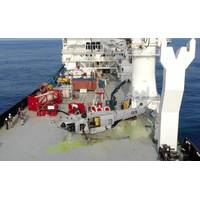
US Navy Recovers Downed Helicopter from Record Ocean Depth
Ridge (LCC-19). CURV successfully rigged and recovered the aircraft from 19,075 feet, a new SUPSALV Record. (Photo: U.S. Navy)The SUPSALV team met the contracted salvage vessel in Guam, completed mobilization of CURV and its deep-lift take-up reel, and departed for the five-day transit. Arriving on the crash site March17, the team began recovery operations. Pulled from its depth of 19,075 FSW, the MH-60S’s recovery broke SUPSALV’s own world depth record for an aircraft recovery.The salvage vessel will proceed to Fleet Activities Yokosuka where the MH-60S will be offloaded for transport back
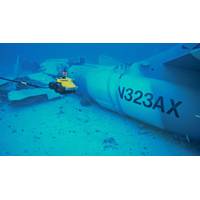
Downed Fighter Jet Recovered off Hawaii
contained the aircraft’s engine, any oil or hazardous substances from the aircraft has either been removed or naturally dissipated and the remaining pieces do not pose a significant or substantial threat to the public or environment,” said Strathern. “Any future actions related to the crash site or remaining debris will be coordinated with the State’s Department of Land and Natural Resources.&rdquo
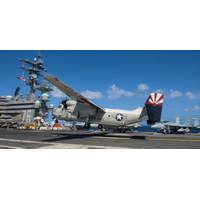
Downed US Navy Aircraft Found in Philippine Sea
following the crash. For the next three days, the U.S. Navy led combined search and rescue for the three missing Sailors with the Japan Maritime Self Defense Force (JMSDF), covering nearly 1,000 square nautical miles before ending the search. In December, the Navy team embarked to the crash site on a contracted salvage vessel, and searched for the aircraft's emergency relocation pinger with the U.S. Navy’s towed pinger locator (TPL-25) system, which uses passive sensors to listen for the pinger's frequency. After poor weather conditions delayed the search efforts, the team
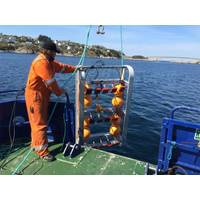
Magnetic Sledge Aids Underwater Object Retrieval
was quickly recovered, accident investigators were anxious to study the helicopter’s transmission. The Accident Investigation Board of Norway consequently commissioned Miko Marine to design and build a sledge that could be used to recover ferro-magnetic debris hidden beneath the seabed around the crash site. Responding to the urgency of the request, Miko engineers were able to design, build and deliver the sledge within four days. The sledge was operated from a 12-meter workboat catamaran that surveyed an area of seabed measuring some 400 by 700 meters, working 12-hour shifts
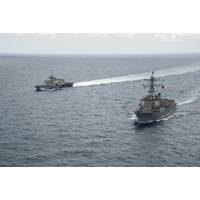
US Navy Ships Exit AirAsia Search
departed from Singapore December 29 and arrived on station in the Java Sea December 30. The guided-missile destroyer with more than 300 crewmembers immediately began conducting surface and aerial searches in coordination with Indonesia's National Search and Rescue Agency (BASARNAS) near the suspected crash site. Capt. Fred Kacher, commodore of Destroyer Squadron 7 and in tactical command of Fort Worth and Sampson during the search efforts reflected, "Throughout both ships' time on station, the crews and divers performed as consummate professionals and superb ambassadors, both at-sea and
Divers Continue Hunt for AirAsia Black Boxes
sea bed about 30 km (20 miles) from the plane's last known location at a depth of around 28-32 meters. "The weather prevented the operation to lift the tail today," search and rescue agency coordinator Supriyadi told reporters in Pangkalan Bun, the southern Borneo town closest to the crash site. Choppy seas, strong currents and poor visibility have dogged the search throughout. "The operation using (a) balloon to lift the tail will start tomorrow," Supriyadi added. The head of Indonesia's search and rescue agency, Fransiskus Bambang Soelistyo, said
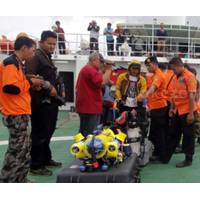
ROVs Aid Recovery Efforts at Air Asia Crash Site
the ROV. The scanning sonar produces detailed images of any objects lying on the ocean floor. One of the primary objectives of the mission is to locate the plane’s black box flight recorder which contains complete details of what was happening on the aircraft, up until the time of the crash. The black box is equipped with an acoustic pinger, which began transmitting a sonar signal when submerged. A gun-like device called the pinger receiver is used to detect the sonar signal being emitted by the pinger. The receiver can either be mounted on an ROV or carried by a diver. Singapore military
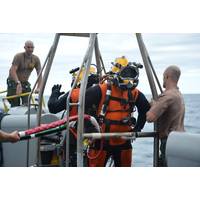
Navy Divers Salvage F-16C Aircraft From GofM
Earp, conducted both towed and autonomous side-scan sonar searches of more than 10 square miles of ocean bottom, before locating the F-16 approximately three miles from the point of the mid-air incident. The MDSU 2 ASP found and recovered aircraft debris using a remote operated vehicle. With the crash site located, the ASP turned over the operation to Navy Divers from Mobile Diving and Salvage (MDS) Company 2-4 who arrived on Grasp after a small-boat transfer. The MDS Company 2-4 divers began surface-supplied diving operations soon afterwards and recovered part of the aircraft from the ocean floor



 February 2024
February 2024





